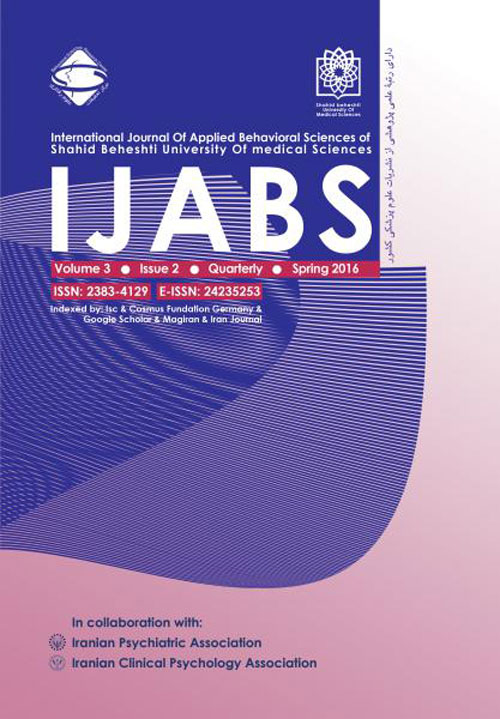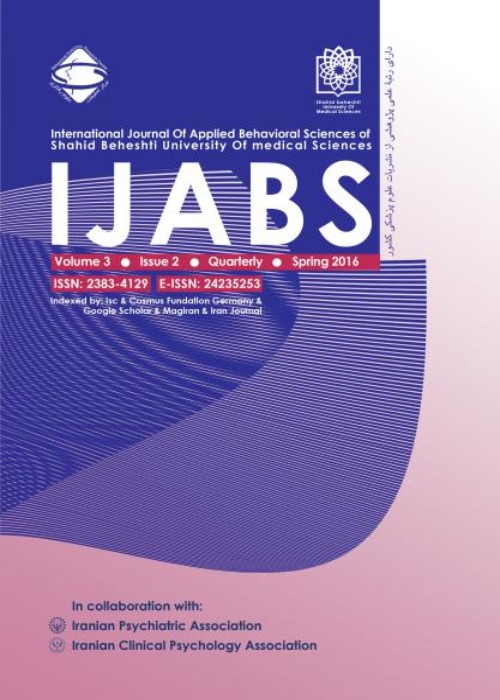فهرست مطالب

International Journal of Applied Behavioral Sciences
Volume:4 Issue: 2, Spring 2017
- تاریخ انتشار: 1396/04/20
- تعداد عناوین: 6
-
-
Pages 1-7IntroductionThe aim of the present study was to investigate the relationship between workaholism and personality traits among bank employees. Participants in this were consisted of Iranian public banks employees working in Mellat, Keshavarzi and Melli bank's branches in three different regions known as Tehran, Rasht, and Abhar city.MethodsSample size was calculated using Cochran formula and included 150 participants. For data collection short form of NEO-FFI questionnaire (the questionnaire for evaluating Big Five) and WorkBAT (Workaholism questionnaire) were used. Data were analyzed through descriptive and correlation analysis based on Structural Equation Modeling.ResultsThere was significant positive correlation between conscientiousness, openness, and extraversion with positive workaholism and positive relationship between agreeableness with positive workaholism. Neuroticism had negative correlation with positive workaholism. Also, our analysis showed that there is a significant positive correlation between conscientiousness and openness with negative workaholism and negative correlation between neuroticism with negative workaholism. There was no relationship between negative workaholism and two other components (agreeableness and extraversion).ConclusionWorkaholism has positive and negative dimensions with two different meanings. According to analysis, the relationship between personality traits and workaholism depends on the aspect that we consider. Declaration of Interest: None.Keywords: Workaholism, Personality traits, Organizational psychology
-
Pages 8-12IntroductionAssertiveness behavior may lead to failure of passive behaviors such as shyness and withdrawal, and in some people, can lead to aggression.The purpose of the present research was to compare the coping styles with assertiveness and aggressiveness in students Imam Khomeini University.MethodsThe number of samples in this research includes 200 of students University (121females and 79 males) from Emam khomeini international university that selected using random cluster sampling and completed the coping styles (CISS) and interpersonal responsibility models(IRM). Data were analyzed using descriptive statistics, one way analysis of variance and T- test.Results[B1] The difference between the behavior aggression and the coping style was 55.31 and the difference between the behavior assertiveness and coping style was 7.03. Also, Data indicated it was relationship between assertiveness and aggressiveness students who have variety coping styles. on the other hand, students who have problem focused coping style, were more assertive and students who have emotion focused coping style, were more aggressive. Also, there were no relationship between females and males assertiveness. But was significant relationship between females and males aggression. males were more aggressive than females.ConclusionConsidering the positive relationship between assertiveness and aggressiveness with coping styles students, and attention to problem focused coping style can reduce aggression and improve assertiveness in students.Keywords: Stress, coping styles, assertiveness, aggressiveness
-
Pages 13-16IntroductionStudies asset the effect of executive function deficit on depression disorder are growing. Therefore, the purpose of this study is comparison of the executive function in students with depression traits and non- depressed students.MethodsEx post facto method used on 15 students with depression traits and 15 non-depressed individuals from students of academic year 2016- 2017 of Shiraz University who were selected through multi-stage random sampling. At first, 200 students was selected by multistage random sampling method from the all undergraduate students and they completed Beck Depression Inventory to select the subjects with depression and Millon clinical multiaxial inventory (MCMI III) in order to exclude subjects with personality disorder criteria. Then, we chose students with depression traits. 15 students with depression traits and 15 non-depressed students completed Wisconsin Card Sorting Test (WCST). The findings were analyzed through descriptive statistic, Multivariate variance analysis using SPSS version 16.ResultsThe sample ranged from 20-24 with an average age of 19.55. Results showed that students with depression traits in comparison with non- depressed students have higher perseveration error and total errors, and lower number of complete (PConclusionSince deficits in cognitive performance and executive function might result in depression, attention to these factors to be modified is efficient.Keywords: Executive function, Depression, Students
-
Pages 17-23BackgroundBreast cancer diagnosis always causes a great deal of stress and result in significant changes in the patients routine life which is apart from physical injuries, can lead to losing social roles and increased risk of mental disorders which can negatively effects their quality of life.ObjectiveThe present study aimed at comparing the effectiveness of cognitive-behavioral group therapy and acceptance and commitment group therapy on quality of life of breast cancer women.MethodsThis is a quasi-experimental pre-test, post-test and follow-up with control group design. Thirty women suffering from breast cancer randomly and equally assigned in to two interventions and a control groups. The treatments consisted of eight weekly acceptance and commitment group therapy and also eight weekly cognitive-behavioral group therapy sessions and follow-up evaluations were carried out two months later. The QLQ-C30, QLQ-BR23 questionnaires were applied in this study.ResultsComparing with cognitive-behavioral group therapy, significant enhancement was indicated in total and all scales of QlQ-C30 and QlQ-BR23 scores in acceptance and commitment group therapys post-test and the results were also preserved at follow-up test.ConclusionsIt is suggested by the findings of this research that acceptance and commitment program appears to be more efficient and feasible therapeutic intervention than cognitive-behavioral therapy for improving quality of life of women suffering from breast cancer.Keywords: Cognitive Behavioral Therapy, Acceptance, Commitment Therapy, Breast Neoplasms, Quality of Life
-
Pages 24-34IntroductionThe present research aimed to investigate the components of listening anxiety & English language classroom anxiety in predicting students English language academic performance.MethodsConsidering the objective, the statistical population included all the female students in the age range of 13 to 18 years old studying in Shokouh language institutes located in Sari, Ghaemshahr, Babol, Babolsar, and Amirkola in the summer trimester of 2016, out of which a sample of 545 language learners was selected through multi-stage random sampling. To collect the data, Foreign Language Classroom Anxiety Scale, Foreign Language Listening Anxiety Scale and Spielberger State-Trait Anxiety Inventory were used and to assess the students English academic performance , their final scores was used.ResultsPearson correlation and stepwise regression analysis were employed to analyze the data subsequent to the administration of the research questionnaires. Research findings indicated the correlation between the components of English language class anxiety, listening anxiety and academic performance in the English language lesson. Based on the results of step-wise regression analysis,these variables explained 41 percent of the changes of academic performance in the language lesson. Given the Betta coefficients, Tension and worry over English Listening had the highest predictive power for academic performance.ConclusionThe practical implications of the present research indicate that necessary plans should be employed to control and decrease the effective factors of students anxiety in English language class and anxiety in listening skill.Keywords: Listening, anxiety, academic performance, adolescents
-
Pages 35-44IntroductionThe present research aimed at studying the relationship between obsessive symptoms and obsessive beliefs with mindfulness, regarding the students at state and non-state universities of Rasht city.MethodsThe design of the study was correlational descriptive. Statistical population in this study included male and female university students during the 2015-2016 academic year of different grades, and the samples in pilot study included 380 whom were selected based on the Morgan Table and multi-step cluster sampling methods. The revised OCI-R for OCD questionnaire as well as OBQ44 obsessive beliefs questionnaire, FFMQ five factor mindfulness questionnaire were used. Also, to analyze the data, multi--variant regression test and Pearson correlation coefficient using SPSS (version 20) were used.ResultsFindings showed that correlated values between obsessive symptoms and obsessive beliefs with students mindfulness, were statistically meaningful (pConclusionResults showed a relation between the obsessive symptoms and obsessive beliefs in students. The more increase in mindfulness observation, the less doubt and obsessive checking would be in students. The more increase in mindfulness actions, the less obsessive compulsive in students and the more increase in non-judgment property towards intrinsic events, the less mind obsessive would be observable.Keywords: Obsession, Signs, Symptoms, Beliefs, Mindfulness


